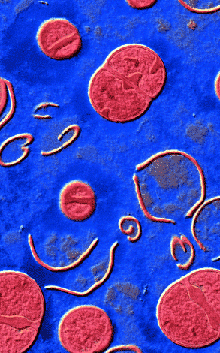'Last resort' antibiotics tested
 China is about to start using a new antibiotic in human medicine, but there is already some resistance to it.
China is about to start using a new antibiotic in human medicine, but there is already some resistance to it.
Colistin is known as an ‘antibiotic of last resort’, but it has been widely used by the agricultural sector in China.
A particular gene - the mcr-1 gene - makes bacteria resistant to colistin and is transferrable between bacteria. Disturbingly, the gene has been found in a wide variety of strains of E.coli following widespread use of colistin in agriculture, and it has even made its way into hospitals.
Colistin is one of a just a few effective treatments for infections that are resistant to carbapenems. Starting in 2015, the mcr-1 gene began to turn up in China, Denmark, Germany, Vietnam, Spain, and the USA among others, raising fears that bacteria may acquire combined colistin and carbapenem resistance, making them multi-drug resistant.
Two studies published this week look at how widespread this growing resistance is.
The first study investigated the prevalence of bacteria carrying the mcr-1 resistance gene in human infections in two hospitals in Zheijang and Guangdong provinces across 8 years.
The researchers found mcr-1 in 76/5332 samples of E.coli and 13/348 samples of Klebsiella pneumoniae.
The study found that people who had used antibiotics (particularly carbapenems) before hospitalisation were more likely to carry bacteria with the mcr-1 resistance gene. Among 146 isolates of mcr-1-positive E.coli identified, five were also carbapenem resistant.
“The emergence of mcr-1 heralds the breach of the last group of antibiotics, such as colistin,” said lead researcher Professor Tim Walsh.
“The withdrawal of the drug from agricultural use, and its introduction in the clinic might reduce colistin resistance rates in the community, and increase resistance in hospitals where they may be harder to treat or spread more easily.
“Our study finds that there are significant risk factors for the spread of mcr-1 infections, beyond just rural living and diet. The spread of colistin resistant bacteria will likely worsen when the drug is introduced in humans,” he said.
The second study tested samples from over 2,000 bloodstream infections at 28 hospitals in China. Of the 1495 E.coli samples, 20 were mcr-1 positive, one of which was also carbapenem resistant.
Patients with mcr-1-positive infections were all treated successfully with other antibiotics.
“The most troubling problem for clinicians would be the transfer of colistin resistance to a bacterium which is already carbapenem resistant, making it multi-drug resistance,” says lead researcher on the second study, Professor Yunsong Yu from Zhejiang University.
“This does not appear to have happened to any great extent in clinical isolates, but the situation should be monitored carefully as the country prepares to introduce colistin for use in humans.”
The studies are published in The Lancet Infectious Diseases, alongside a comment from Professor David Paterson at the University of Queensland, who writes: “at this stage we can conclude that the doomsday scenario of convergence of carbapenem resistance and colistin resistance (via mcr-1) has not yet occurred to any great extent in China.”
“However, prior use of carbapenems was a risk factor for mcr-1 producing E.coli, perhaps implying that the intersection between carbapenem resistance and the presence of this colistin resistance mechanism may yet be seen in the future.
“Furthermore, the spread of mcr-1 into globally widespread and virulent strains of E.coli such as ST-131 is cause for ongoing concern and surveillance.
“After carbapenems, new antibiotics will become available for clinical use in human medicine in China.
“There are risks that low-cost generic copies of these new antibiotics will be used in agriculture. We must be vigilant to this possibility and urge Chinese authorities to proactively prohibit use of these critical antibiotics outside of appropriate human use.
“Without such interventions, there will doubtless be more serious problems than mcr-1 seen in China in the near future.”
The first study, on the resistant gene is hospitals, is available here. The report on the possibility of multi-drug resistance is available here.







 Print
Print